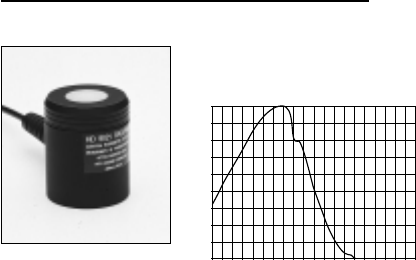
The typical response curve of the probe is
as follows:
The study and field of application of ultraviolet rays has seen considerable
growth in the last decades. The ultraviolet field is conventionally subdivi-
ded into the following three "bands":
- the band between the wavelengths from 400 to 315 nm. which includes
radiations defined as type A or UVA;
- the band between the wavelengths from 315 to 280 nm. which includes
radiations defined as type B or UVB;
- the band between the wavelengths from 280 to 100 nm. which includes
radiations defined as type C or UVC.
The ultraviolet rays in natural light as it reaches earth through the atmo-
sphere are of type A.
The amount of UVA in natural light is much greater than that emitted by
traditional, incandescent bulbs, halogen or fluorescent lamps.
Save in the case of prolonged exposure, UVA rays possess a marked tan-
ning action; they are not harmful to man but they may give rise to biological
effects that may be beneficial for his health. The problem is the time of
exposure; in fact, UVA rays have a considerable photochemical action that
in the course of time produces phenomena of fading, cracking and decay.
Ultraviolet rays of type B or UVB have the property of encouraging the for-
mation of vitamin D, but unless suitable precautions are taken they may
cause erythema or conjunctivitis. The amount of UVB rays emitted by tra-
ditional lamps is very little in comparison with that emitted by sunlight and
they are also much less than UVA rays.
ENGLISH
– 44 –
850.0
800.0
750.0
700.0
650.0
600.0
550.0
500.5
450.0
400.0
0.00
0.11
0.22
0.33
0.44
0.56
0.67
0.78
0.89
1.00
900.0


















